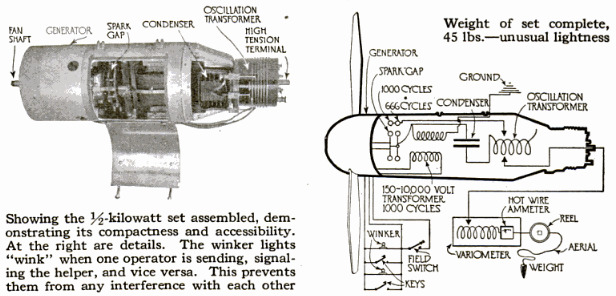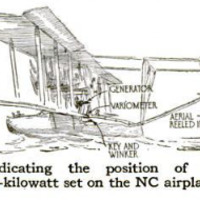The radio system used to communicate with seaplanes during the transatlantic flight experiment
Item
-
Title (Dublin Core)
-
The radio system used to communicate with seaplanes during the transatlantic flight experiment
-
Article Title and/or Image Caption (Dublin Core)
-
Radio and the NC Planes
-
extracted text (Extract Text)
-
OF surpassing interest the last few
weeks has been the flight of the
American naval airplanes across the
Atlantic. Little has been given out as
to the airplanes’ radio-telegraphic and
-telephonic equipment. And yet, these
instruments were as important to suc-
cess as the airplanes’ other features—
often their sole eyes and ears. POPULAR
SCIENCE MONTHLY is fortunate this
month in being able to present details
on this exceptional radio equipment.
The NC boats have two complete
radio sets. One is of 1/2-kilowatt
capacity, with a normal sending radius
of 300 to 400 miles, though under
especially favorable conditions this
may go to 1,500 miles. The generator
on this set is wind-driven. The other
radio unit is operated by a compact
12-volt storage battery. With this set
both radio-telegraphic and -telephonic
communication may be carried on.
The sets performed remarkably at
all times during the flights. At one
time the Assistant Secretary of the
Navy in Washington filed a message
inquiring the position of one of the
airplanes. Within three minutes a re-
ply was received, uncommonly quick
time. Balboa, Canal Zone, and San
Diego heard also.
The battery unit is installed to
permit communication when the air-
plane is riding on the water and the
wind therefore insufficient to operate
the generator on the other unit.
This set's aerial is up on the skid fins
of the upper wings—well out of the
water at all times. The 1/2-kilowatt
set’s consists of 250 feet of wire, which
trails out below and behind when the
airplane is in the air, but which is
reeled in upon descent.
The especially prominent feature
about the 1/2 -kilowatt set is its com-
pactness and light weight—45 Ibs.
Experts acquainted with the set say
that this reflects unusual credit on
American technique. An ordinary 14-
kilowatt set used on shipboard may
weigh 600 lbs. Generator, spark-
gap, transformer, condensers, and so
forth, are all contained within a single
stream-lined body. As is apparent
from the illustration, the spark-gap
has two rotors, one with twelve pro-
jections and the other with eight. Both
revolve at the same rate, but one de-
livers 1,000 sparks a second and the
other 666, thus producing two distinct
tones, either of which the operator may
use, and which permit greater selec
tivity, or the choosing of the tone best
able to carry through radio traffic
in the region at the moment.
The diaphragm on the telephone
transmitter is open front and rear,
so that engine noises neutralize them-
selves. But the operator's voice
reaches but one side, so its impulses
carry through. Radio operator, pilot,
navigating officer, engine man, helpers
—in fact, the whole crew of five or
six men—are all in intercommunica-
tion at all times by telephone, and
naturally with the other planes if
they happen to be within the in-
strument’s working radius, around
20 miles. The telegraph part of the
set will reach about 30 miles, though
of course these distances become
greater or less with varying atmos-
pheric and ether conditions as with
any radio apparatus.
Within the tail of the plane, coils
forming the radio compass are mount-
ed. These are revolved at will by
the operator through the aid of suita-
ble connecting mechanism, and are
most important in helping the plane
locate itself with respect to ship and
land stations.
The “NC” in the airplanes’ names
comes from “N,” Navy, and “C,”
Curtiss, indicating the type. The
number that accompanies the “NC”
denotes merely numerical order.
-
Language (Dublin Core)
-
eng
-
Date Issued (Dublin Core)
-
1919-07
-
pages (Bibliographic Ontology)
-
114-115
-
Rights (Dublin Core)
-
Public domain (Google digitized)
-
Archived by (Dublin Core)
-
Davide Donà
-
Alberto Bordignon (Supervisor)
 Popular Science Monthly, v. 95, n. 1, 1919
Popular Science Monthly, v. 95, n. 1, 1919






